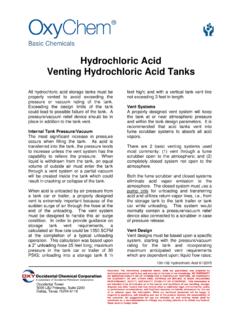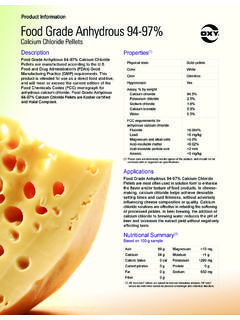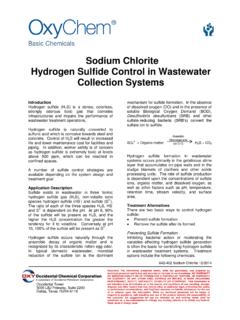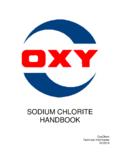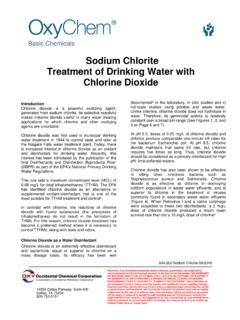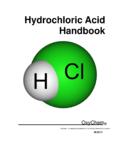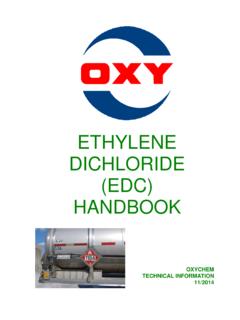Transcription of Sodium Hypochlorite Handbook
1 TABLE OF CONTENTS. OxyChem Sodium Hypochlorite Handbook Introduction 2. Foreword Properties 3. This Handbook outlines recommended methods for handling, storing, and using Sodium Hypochlorite . It also Concentration Terminology 5. includes information on the manufacture, physical properties, safety considerations and analytical methods for testing Sodium Manufacturing 6. Hypochlorite . Additional information and contacts can be found at Handling and Storage 9. Safety Handling 11. Unloading Tank Trucks 14. Physical Property Data 16. Methods of Analysis 18. Typical Storage Tank Installation 23. Important: The information presented herein, while not guaranteed, was prepared by technical personnel and is true and accurate to the best of our knowledge. NO WARRANTY OF MERCHANTABILITY OR OF FITNESS. FOR A PARTICULAR PURPOSE, OR WARRANTY OR GUARANTY OF ANY OTHER KIND, EXPRESS OR.
2 IMPLIED, IS MADE REGARDING PERFORMANCE, SAFETY, SUITABILITY, STABILITY OR OTHERWISE. This information is not intended to be all-inclusive as to the manner and conditions of use, handling, storage, disposal and other factors that may involve other or additional legal, environmental, safety or performance considerations, and Occidental Chemical Corporation assumes no liability whatsoever for the use of or reliance upon this information. While our technical personnel will be happy to respond to questions, safe handling and use of the product remains the responsibility of the customer. No suggestions for use are intended as, and nothing herein shall be construed as, a recommendation to infringe any existing patents or to violate any Federal, State, local or foreign laws. INTRODUCTION. This Handbook provides information Sodium Hypochlorite solutions have In 1798, Tennant of England prepared concerning Sodium Hypochlorite or attained widespread use in bleaching a solution of calcium Hypochlorite by bleach, solutions.
3 An attempt has been operations and as disinfectants, both chlorinating a slurry of relatively made to give comprehensive coverage in the home and in industry. inexpensive lime. The following year of the subject. If additional technical he patented a process for the information or specific Scheele, a Swedish chemist, is manufacture of bleaching powder recommendations regarding soda generally credited with discovering where chlorine gas was absorbed in a bleach solutions are desired, the chlorine in 1774. During his dry lime hydrate. Technical Service Group of Occidental experiments, he found that a solution Chemical Corporation will be pleased of chlorine in water possessed definite Labarraque succeeded, in 1820, in to provide assistance. Requests for bleaching properties. Since the preparing Sodium Hypochlorite by such information should be made to reaction between chlorine and water chlorinating a solution of caustic soda.
4 Your local OxyChem representative. forms hydrochloric and hypochlorous Varying concentrations of this solution acids, early textile bleaching have found a multitude of applications Some safety and handling information so that the general public is now well experiments were not successful has been taken directly from the acquainted with the material. This because of damaged cloth. Chlorine Institute's Pamphlet 96 with Handbook will discuss Sodium the permission of the Chlorine In 1789, the French chemist Berthollet Hypochlorite solutions. Institute. Pamphlet 96 also contains succeeded in chlorinating a solution of additional information on Sodium potash, forming a potassium Hypochlorite . Hypochlorite solution. This solution proved to be a more successful bleach For further information regarding for textiles due to the absence of caustic soda and chlorine, refer to the hydrochloric acid.
5 However, it never appropriate OxyChem Handbook . gained more than limited usage in the bleaching field, primarily because of the high cost of potash. 2. PROPERTIES OF Sodium Hypochlorite . CHEMICAL PROPERTIES Hypochlorous acid is a significantly OXIDIZING POWER. Chlorine (Cl2) is the best overall more powerful oxidizer and Eq. 2 shows the oxidation of two disinfectant, germicide, algaecide and disinfectant than Hypochlorite . Best moles of potassium iodide (KI) with anti-slime agent. Chlorination and biological control is achieved in the pH one mole of Sodium Hypochlorite in a filtration of drinking water is range of 5 to 7 where hypochlorous solution of acetic acid to iodine (I2). responsible for a nearly fifty percent acid is predominate. reduction in deaths due to disease in 2) NaOCl + 2 CH3 COOH + 2 KI.
6 Major cities during the late 19th and Hypochlorous acid is extremely NaCl + 2 CH3 COOK + I2 + H2O. early 20th centuries and the near unstable. It is much easier to handle elimination of typhoid fever. Infants the more stable hypochlorites. The Eq. 3 shows the oxidation of two and children benefiting the most. term hypochlorites refers to the salt of moles of potassium iodide with one Calcium Hypochlorite was the first hypochlorous acid. One of the best mole of chlorine to iodine. chlorinating agent used. known hypochlorites is Sodium Hypochlorite , the active ingredient in 3) Cl2 + 2 KI 2 KCl + I2. Chlorine also oxidizes and eliminates bleach. The molecular formula for organic compounds and converts Sodium Hypochlorite is NaOCl. Given that one mole of Sodium some soluble metallic impurities into Hypochlorite can oxidize the same insoluble solids that can be removed Na+ + OCl- NaOCl amount of iodide to iodine as one mole by filtration.
7 Sodium hypo- Sodium of chlorine they have equal oxidizing cation chlorite Hypochlorite power. Therefore, the available Chlorine is soluble in water to about anion chlorine in Sodium Hypochlorite 7000 ppm at 68 F. It reacts with water equals the amount of chlorine used to forming hypochlorous acid (HOCl). In The most common method for produce it and Sodium chloride (see alkali solutions hypochlorous acid producing Sodium Hypochlorite is to Eq. 1) in oxidizing power. dissociates forming Hypochlorite react chlorine with Sodium hydroxide (OCl-). Chlorine, hypochlorous acid (NaOH). The reaction by-products are DECOMPOSITION REACTIONS. and Hypochlorite exist together in Sodium chloride (salt, NaCl) and water Sodium Hypochlorite is stable above equilibrium. (H2O). pH 12 where the less reactive Hypochlorite is predominant and Cl2 + H2O HOCl OCl- 1) Cl2 + 2 NaOH hypochlorous acid is virtually Increasing pH NaOCl + NaCl + H2O + HEAT nonexistent.
8 The figure below shows the effect pH SYNONYMS Decomposition is by Eq. 4 and 5. has on the equilibrium. Hypo Liquid bleach Hypochlorite Soda bleach 4) 3 NaOCl NaClO3 + 2 NaCl Bleach Javel water Chlorine bleach 5) 2 NaOCl O2 + 2 NaCl Eq. 4 is the major decomposition APPLICTIONS reaction forming chlorate (ClO3-) and Disinfection chloride (Cl-). This reaction is Removal of ammonia temperature and concentration Control taste and odor dependent; it is not catalytic. Eq. 5 is Hydrogen sulfide oxidation catalytic, forming oxygen (O2) and Iron and manganese oxidation chloride. Trace metals such as nickel, Below pH 2 the equilibrium favors Destruction of organic matter cobalt and copper form metal oxides, chlorine. Between pH 2 and Color reduction which cause catalytic decomposition. hypochlorous acid predominates and Control of slime and algae Light also catalyzes this reaction.
9 Above pH Hypochlorite Laundry Bleaching predominates. PROPERTIES OF Sodium HYPOCHLORITES. STABILITY temperatures improve the stability of The most effective of these techniques Although more stable than Hypochlorite solutions, freezing should is polishing the finished bleach with a hypochlorous acid, Sodium be avoided. Sodium Hypochlorite to 1 micron filter. It removes Hypochlorite is unstable. It starts solutions will freeze at different insoluble metal oxides that catalyze decomposing immediately. With temperatures depending on the decomposition and sediments that proper care, the rate of decomposition concentration of the solution. Thirteen affect product appearance. This level can be reduced such that relatively wt% Sodium Hypochlorite freezes at of filtration is difficult and expensive to stable solutions can be prepared.
10 C compared to 6 wt% Sodium achieve using cartridge type filters. A. Hypochlorite which freezes at C. filter that uses a filter aid such as The stability and shelf life of a diatomaceous earth is needed. Hypochlorite solution depends on five The quality and stability of Sodium major factors: Hypochlorite solutions can be affected Sunlight (ultraviolet light) catalyzes by the concentration of certain Hypochlorite decomposition by Eq. 5. Hypochlorite concentration. impurities. Trace metals such as Opaque (non-translucent). pH of the solution. nickel, cobalt and copper form containers for Hypochlorite solutions Temperature of the solution. insoluble metal oxides, which cause will reduce decomposition due to light. Concentration of certain impurities the bleach to catalytically decompose which catalyze decomposition.
